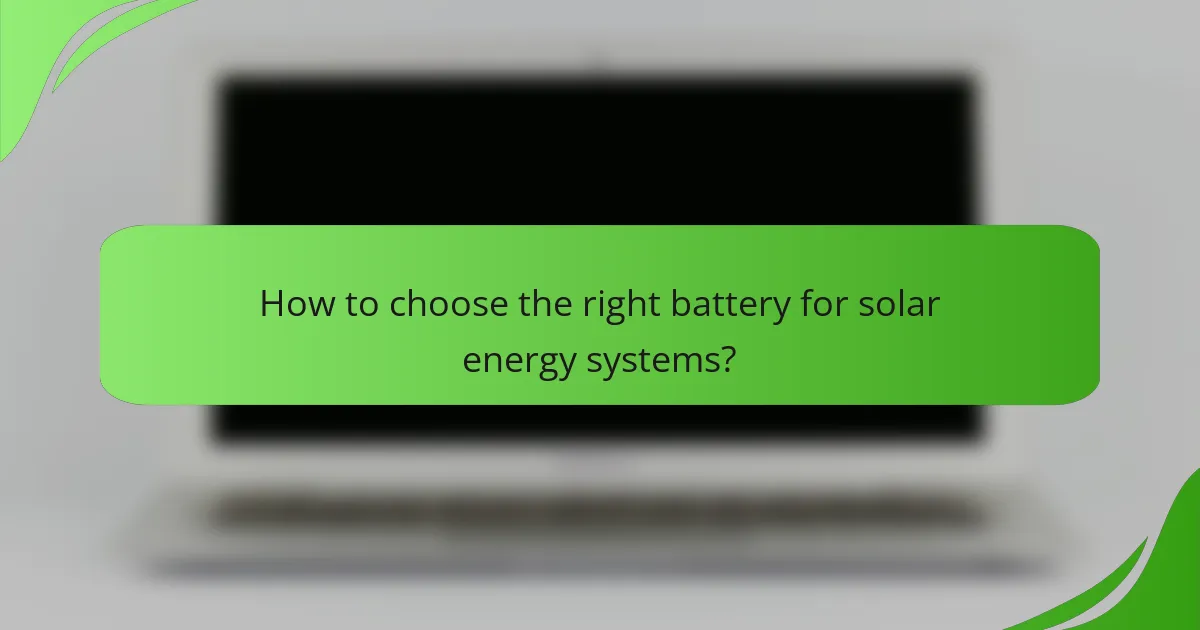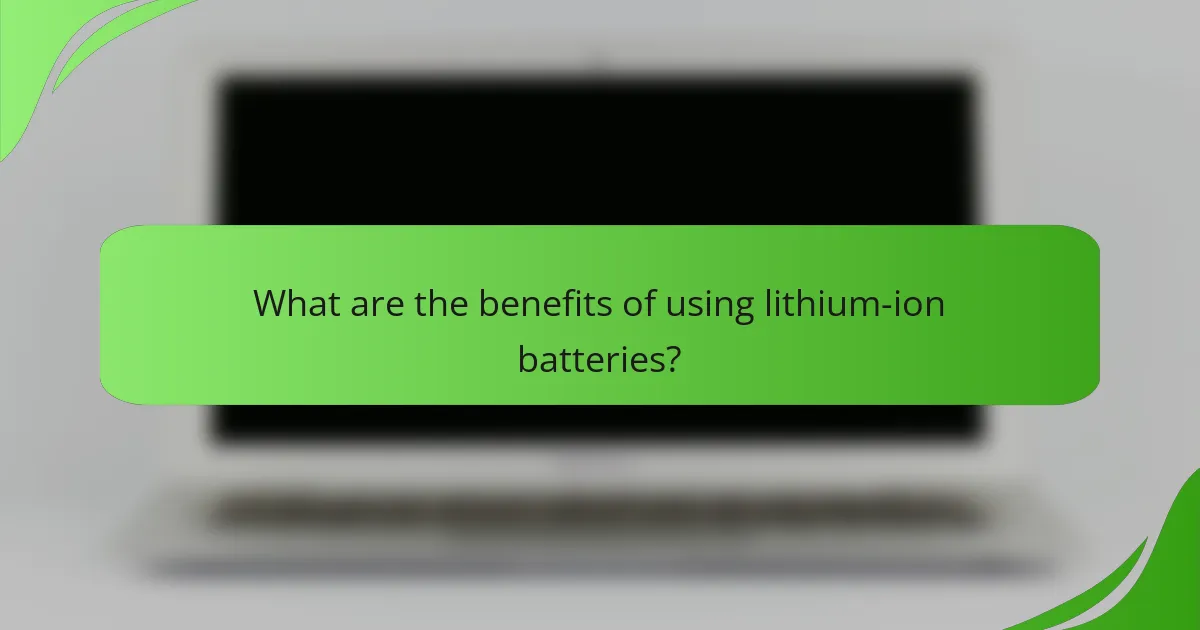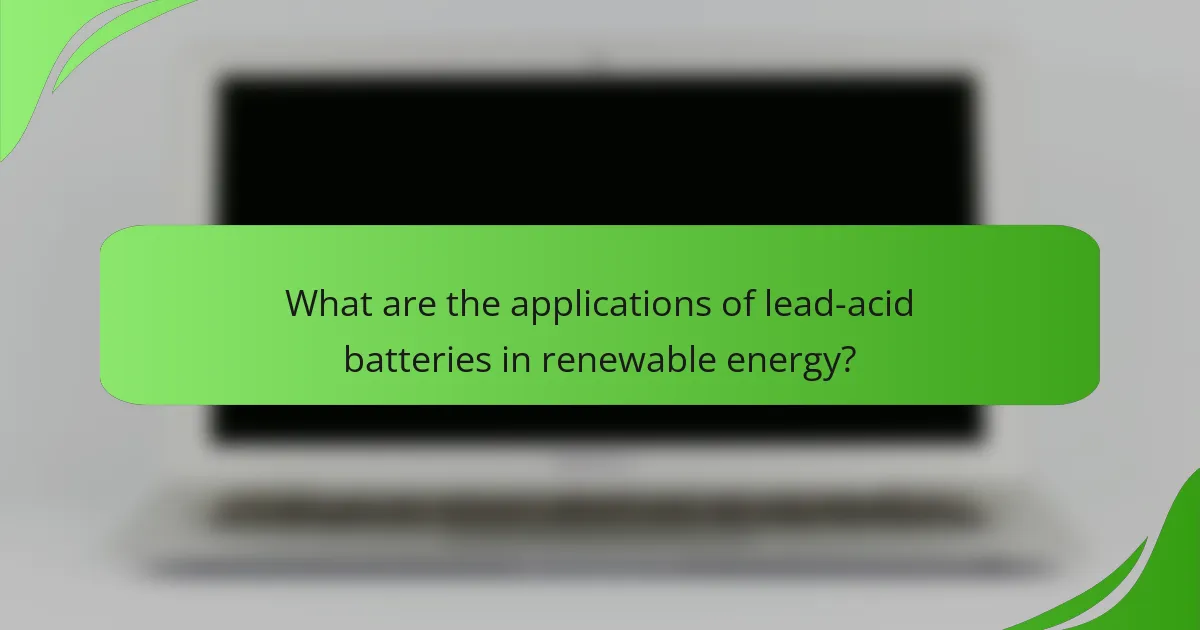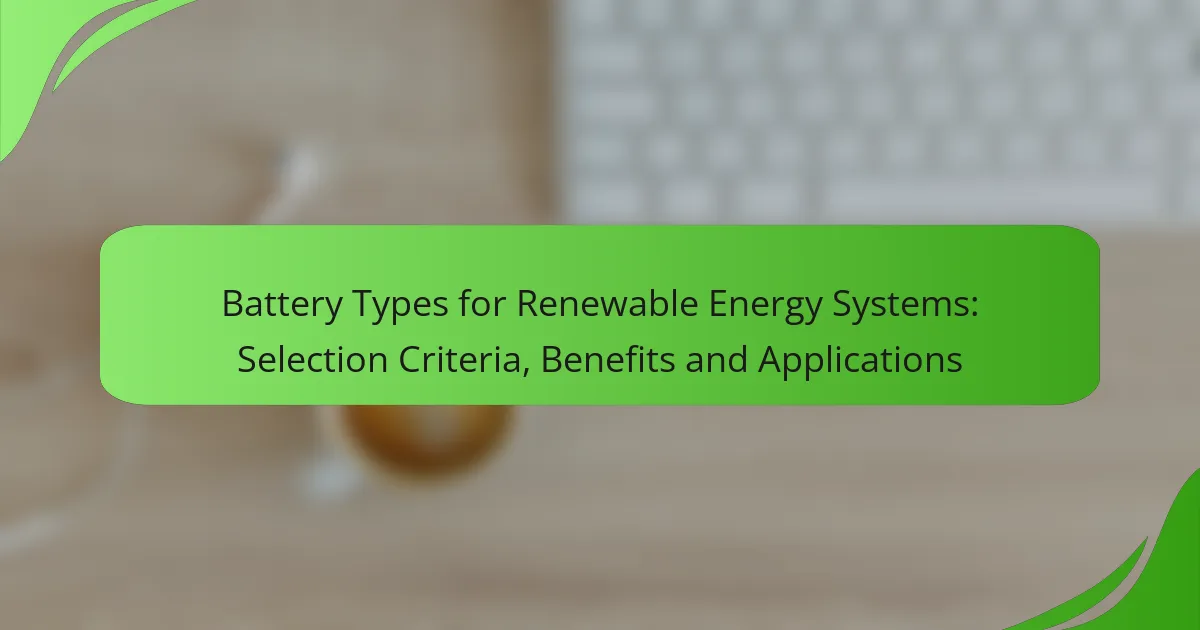In the realm of renewable energy systems, selecting the appropriate battery type is crucial for optimizing performance and efficiency. Options such as lithium-ion, lead-acid, and flow batteries each present unique benefits and applications, making it essential to evaluate criteria like energy capacity, discharge rates, and lifespan. Understanding these factors will help ensure that the chosen battery aligns with specific energy needs and operational requirements.

What are the best battery types for renewable energy systems?
The best battery types for renewable energy systems include lithium-ion, lead-acid, nickel-cadmium, flow, and sodium-sulfur batteries. Each type has distinct characteristics that make it suitable for specific applications, performance requirements, and cost considerations.
Lithium-ion batteries
Lithium-ion batteries are widely favored in renewable energy systems due to their high energy density, efficiency, and long cycle life. They typically have a lifespan of 10-15 years and can achieve charge and discharge efficiencies of around 90-95%.
These batteries are ideal for applications requiring quick response times and frequent cycling, such as solar energy storage. However, they can be more expensive upfront compared to other types, so it’s essential to evaluate the total cost of ownership over their lifespan.
Lead-acid batteries
Lead-acid batteries are one of the oldest battery technologies and are commonly used in renewable energy systems for their low initial cost and reliability. They are available in two main types: flooded and sealed (AGM or gel), each with different maintenance needs and performance characteristics.
While lead-acid batteries are less efficient than lithium-ion batteries, with efficiencies around 70-80%, they are suitable for applications with lower depth of discharge requirements. Their shorter lifespan of 3-5 years can be a drawback, particularly in high-cycling scenarios.
Nickel-cadmium batteries
Nickel-cadmium (NiCd) batteries offer excellent performance in extreme temperatures and have a long cycle life, often exceeding 15 years. They are particularly effective in applications requiring high discharge rates and can tolerate deep discharges without significant damage.
However, the use of cadmium raises environmental concerns, and these batteries are generally more expensive than lead-acid options. They are less commonly used in new renewable energy projects due to these factors and the availability of more efficient alternatives.
Flow batteries
Flow batteries are unique in that they store energy in liquid electrolytes, allowing for scalable energy storage solutions. They are particularly advantageous for large-scale renewable energy systems, such as solar and wind farms, due to their ability to provide long-duration energy storage.
While flow batteries have lower energy density compared to lithium-ion batteries, they excel in applications requiring long discharge times and can last for over 20 years with minimal degradation. Their higher initial costs and complexity can be a barrier for smaller projects.
Sodium-sulfur batteries
Sodium-sulfur (NaS) batteries are high-temperature batteries that offer high energy density and long cycle life, making them suitable for large-scale energy storage applications. They can operate efficiently in temperatures around 300-350°C and are often used in grid storage solutions to balance supply and demand.
Despite their advantages, NaS batteries have high operating temperatures that require specialized equipment and safety measures. Their cost and complexity may limit their use in smaller renewable energy systems, but they are promising for utility-scale applications.

How to choose the right battery for solar energy systems?
Choosing the right battery for solar energy systems involves considering several key factors that affect performance and suitability for your specific needs. Key criteria include energy capacity, discharge rates, lifespan, and temperature tolerance, each playing a vital role in the overall efficiency and reliability of the system.
Consider energy capacity
Energy capacity refers to the total amount of energy a battery can store, typically measured in kilowatt-hours (kWh). For solar energy systems, it is crucial to select a battery that can adequately meet your energy demands, especially during periods of low sunlight. A common guideline is to aim for a battery capacity that can cover at least one to three days of your household energy usage.
When assessing energy capacity, consider your daily energy consumption and the peak load requirements. For instance, if your home uses around 30 kWh per day, a battery system with a capacity of 30-90 kWh would be appropriate to ensure sufficient backup during cloudy days or nighttime.
Evaluate discharge rates
Discharge rates indicate how quickly a battery can release its stored energy, typically expressed in C-rates. A higher discharge rate allows for more energy to be used quickly, which is essential for applications with sudden power demands. For solar systems, look for batteries that can sustain a discharge rate of at least 0.5C to 1C for optimal performance.
It’s important to match the discharge rate with your energy usage patterns. For example, if you have high-power appliances that require significant energy in short bursts, a battery with a higher discharge rate will be necessary to prevent performance issues.
Assess lifespan and cycles
The lifespan of a battery is often measured in charge cycles, which indicates how many times a battery can be fully charged and discharged before its capacity significantly diminishes. Most lithium-ion batteries last between 2,000 to 5,000 cycles, while lead-acid batteries typically offer 500 to 1,500 cycles. Selecting a battery with a longer lifespan can lead to lower long-term costs.
Consider your usage patterns when evaluating lifespan. If you frequently cycle your battery, opt for one with a higher cycle rating. Additionally, look for warranties that reflect the expected lifespan, as this can provide insight into the manufacturer’s confidence in their product.
Analyze temperature tolerance
Temperature tolerance is critical for battery performance, as extreme temperatures can affect efficiency and lifespan. Most batteries operate best within a temperature range of 20°C to 25°C (68°F to 77°F). Operating outside this range can lead to reduced capacity and increased wear.
When selecting a battery, consider your local climate. If you live in an area with high temperatures, look for batteries specifically designed for better heat tolerance. Conversely, in colder climates, ensure the battery can handle low temperatures without significant performance loss.

What are the benefits of using lithium-ion batteries?
Lithium-ion batteries offer several advantages for renewable energy systems, including high energy density, long lifespan, fast charging capabilities, and low maintenance requirements. These features make them a popular choice for applications ranging from residential solar storage to large-scale energy management systems.
High energy density
Lithium-ion batteries are known for their high energy density, which means they can store more energy in a smaller volume compared to other battery types. This characteristic is particularly beneficial in applications where space is limited, such as in residential solar setups or electric vehicles.
Typically, lithium-ion batteries can achieve energy densities of around 150-250 Wh/kg. This allows for lighter and more compact energy storage solutions, making them ideal for both portable and stationary applications.
Long lifespan
One of the standout features of lithium-ion batteries is their long lifespan, often exceeding 10 years with proper management. This longevity reduces the frequency of replacements, making them a cost-effective option over time.
In practical terms, lithium-ion batteries can endure several thousand charge cycles, depending on usage patterns and depth of discharge. This durability is crucial for renewable energy systems that require reliable performance over extended periods.
Fast charging capabilities
Lithium-ion batteries can be charged quickly, often reaching 80% capacity in under an hour. This rapid charging capability is essential for applications that require quick turnaround times, such as electric vehicles and grid storage solutions.
For renewable energy systems, this means that during peak sunlight hours, batteries can be charged efficiently, allowing for better energy management and utilization throughout the day.
Low maintenance
Another significant advantage of lithium-ion batteries is their low maintenance needs. Unlike lead-acid batteries, which require regular checks and fluid top-ups, lithium-ion batteries are generally maintenance-free.
This low maintenance requirement simplifies the operation of renewable energy systems, allowing users to focus on energy production and consumption rather than battery upkeep. Regular monitoring of battery health is still advisable, but the overall effort is minimal compared to other battery technologies.

What are the applications of lead-acid batteries in renewable energy?
Lead-acid batteries are commonly used in renewable energy systems due to their reliability, cost-effectiveness, and established technology. They serve various applications, including off-grid solar systems, backup power solutions, and electric vehicles.
Off-grid solar systems
In off-grid solar systems, lead-acid batteries store energy generated from solar panels for use when sunlight is not available. These batteries are typically used in remote locations where grid access is limited or nonexistent. Their ability to handle deep discharges makes them suitable for daily cycling in these applications.
When selecting lead-acid batteries for off-grid systems, consider factors such as capacity, discharge rates, and temperature tolerance. A common choice is the flooded lead-acid battery, which offers a good balance of performance and cost, typically ranging from 100 to 400 amp-hours.
Backup power solutions
Lead-acid batteries are widely used in backup power systems to provide emergency electricity during outages. They can quickly supply power to critical loads, such as lighting, refrigeration, and communication devices. These batteries are often integrated with uninterruptible power supplies (UPS) for seamless transitions.
For effective backup solutions, ensure that the battery capacity matches the expected load duration. A general rule of thumb is to have enough capacity to sustain essential devices for several hours, depending on the frequency and duration of power outages in your area.
Electric vehicles
Lead-acid batteries have been historically used in electric vehicles (EVs), particularly in older models and low-speed applications like golf carts and forklifts. They provide a cost-effective solution for short-range travel, although they are being gradually replaced by more efficient battery technologies.
When considering lead-acid batteries for electric vehicles, evaluate their weight, energy density, and cycle life. While they are less efficient than lithium-ion batteries, they can still serve niche markets where lower costs are prioritized over performance.

What factors influence battery selection for wind energy systems?
Battery selection for wind energy systems is influenced by energy storage requirements, cost, lifespan, and efficiency. Understanding these factors helps in choosing the right battery type to optimize performance and investment.
Energy storage requirements
Energy storage requirements for wind energy systems depend on the capacity needed to balance supply and demand. This includes considering the average wind generation, peak load periods, and the duration for which energy needs to be stored. For instance, systems may require batteries that can store energy for several hours to days, depending on local wind patterns.
When assessing energy storage needs, evaluate the expected daily and seasonal variations in wind energy production. A common approach is to size the battery capacity to handle at least one to three days of energy consumption, ensuring reliability during low wind periods.
Cost considerations
Cost is a critical factor in battery selection for wind energy systems. The initial investment, maintenance expenses, and overall lifecycle costs should be analyzed. Lithium-ion batteries, while more expensive upfront, often offer longer lifespans and higher efficiency, which can lead to lower costs over time compared to lead-acid batteries.
It’s essential to consider not only the purchase price but also the total cost of ownership, including installation and potential incentives or subsidies available for renewable energy projects. Comparing the cost per kilowatt-hour (kWh) of different battery technologies can provide a clearer picture of long-term financial implications.
Lifespan and efficiency
The lifespan and efficiency of batteries significantly affect their suitability for wind energy systems. Battery lifespan is typically measured in charge cycles, with many lithium-ion batteries lasting several thousand cycles, while lead-acid batteries may only last a few hundred. Higher efficiency translates to less energy loss during charging and discharging, which is crucial for maximizing the utility of generated wind energy.
When selecting a battery, consider the expected usage patterns and how they align with the battery’s cycle life. For example, if the system will frequently cycle through charging and discharging, a battery with a longer lifespan and higher efficiency will likely yield better performance and lower replacement costs over time.
